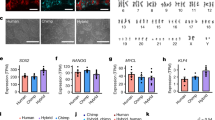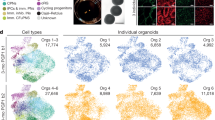Abstract
Human central nervous system (CNS) cell lines would substantially facilitate drug discovery and basic research by providing a readily renewable source of human neurons. We isolated clonal human CNS cell lines that had been immortalized with a tetracycline (Tc)-responsive v-myc oncogene; addition of Tc to the growth medium suppressed the oncoprotein rapidly and virtually completely, allowing differentiation to proceed. Two classes of bipotent precursor cells were immortalized: the first class had a default differentiation pathway of neurons only, and the second class had a default differentiation pathway of neurons and astrocytes. We found that after exposure to different external signals in vitro, the environment is capable of redirecting the fate of a particular cell, even in the case of the bipotent precursor cell whose default differentiation pathway was neurons only. These data suggest that extrinsic cues can prevail over intrinsic determinants in directing cell fate in the human CNS.
This is a preview of subscription content, access via your institution
Access options
Subscribe to this journal
Receive 12 print issues and online access
$209.00 per year
only $17.42 per issue
Buy this article
- Purchase on Springer Link
- Instant access to full article PDF
Prices may be subject to local taxes which are calculated during checkout
Similar content being viewed by others
References
Younkin, D.P., Tang, C.-M., Hardy, M., Reddy, U.R., Shi, Q.-Y, Pleasure, S.J., et al. 1993. Inducible expression of neuronal glutamate receptor channels in the NT2 human cell line. PNAS 90: 2174–2178.
Hoshimaru, M., Ray, J., Sah, D.W.Y., and Gage, F.H. 1996. Differentiation of the immortalized adult neuronal progenitor cell line HC2S2 into neurons by regulat-able suppression of the v-myc oncogene. Proc. Natl. Acad Sci. USA 93: 1518–1523.
Temple, S. 1989. Division and differentiation of isolated CMS blast cells in microculture. Nature 340: 471–473.
Reynolds, B.A., Tetzlaff, W., and Weiss, S. 1992. A multipotent EGF-responsive striatal embryonic progenitor cell produces neurons and astrocytes. J. Neurosci. 12: 4565–4574.
Kilpatrick, T.J. and Bartlett, P.P. 1993. Cloning and growth of multipotential neural precursors: requirements for proliferation and differentiation. Neuron 10: 255–265.
Fredrikson, K., Jat, P.S., Valtz, N., Levy, D., and McKay, R. 1988. Immortalization of precursor cells from the mammalian CMS. Neuron 1: 439–448.
Ryder, E.F., Snyder, E.Y., and Cepko, C.L. 1990. Establishment and characterization of multipotent neural cell lines using retrovirus vector-mediated oncogene transfer. J. Neurobiol. 21: 356–375.
Renfranz, P.J., Cunningham, M.G., and McKay, R. 1991. Region-specific differentiation of the hippocampal stem cell line HiB5 upon implantation into the developing mammalian brain. Cell 66: 713–729.
Stemple, D.L. and Anderson, D.J. 1993. Isolation of a stem cell for neurons and glia from the mammalian neural crest. Cell 71: 973–985.
Lo, L. and Anderson, D.J. 1995. Postmigratory neural crest cells expressing c-RET display restricted developmental and proliferative capacities. Neuron 15: 527–539.
Kubo, Y. 1989. Development of ion channels and neurofilaments during neuronal differentiation of mouse embryonal carcinoma cell lines. J. Physiol. 409: 497–523.
Cheun, J.E. and Yeh, H.H. 1991. Differentiation of astern cell line toward a neuronal phenotype. Int. J. Dev. Neurosci. 9: 391–404.
Arreola, J., Spires, S., and Begenisich, T. 1993. Na+ channels in cardiac and neuronal cells derived from a mouse embryonal carcinoma cell line. J. Physiol. 472: 289–303.
Turetsky, D.M., Huettner, J.E., Gottlieb, D.I., Goldberg, M.P., and Choi, D.W. 1993. Glutamate receptor-mediated currents and toxicity in embryonal carcinoma cells. J. Neurobiol. 24: 1157–1169.
Carbone, E., Sher, E., and Clementi, F. 1990. Ca currents in human neuroblastoma IMR32 cells: kinetics, permeability and pharmacology. Pflugers Arch. 416: 170–179.
Seward, E.P. and Henderson, G. 1990. Characterization of two components of the N-like, high-threshold-activated calcium channel current in differentiated SH-SY5Y cells. Pflugers Arch. 417: 223–230.
Mienville, J.-M. 1992. Voltage-clamp study of calcium currents during differentiation in the NCB-20 neuronal cell line. Cell. Mol. Neurobiol. 12: 285–295.
Lesser, S.S., and Lo, D.C. 1995. Regulation of voltage-gated ion channels by NGF and ciliary neurotrophic factor in SK-N-SH neuroblastoma cells. J. Neurosci. 15: 253–261.
Gossen, M. and Bujard, H. 1992. Tight control of gene expression in mammalian cells by tetracycline-responsive promoters. Proc. Natl. Acad. Sci. USA 89: 5547–5551.
Gage, F.H., Coates, P.W., Palmer, T.D., Kuhn, H.G., Fisher, L.J., Suhonen, J.O., et al. 1995. Survival and differentiation of adult neuronal progenitor cells transplanted to the adult brain. Proc. Natl. Acad. Sci. USA 92: 11879–11883.
Author information
Authors and Affiliations
Rights and permissions
About this article
Cite this article
San, D., Ray, J. & Gage, F. Bipotent progenitor cell lines from the human CNS. Nat Biotechnol 15, 574–580 (1997). https://doi.org/10.1038/nbt0697-574
Received:
Accepted:
Issue Date:
DOI: https://doi.org/10.1038/nbt0697-574
This article is cited by
-
Fluorescence imaging of in vivo miR-124a-induced neurogenesis of neuronal progenitor cells using neuron-specific reporters
EJNMMI Research (2016)
-
Characterisation of neurons derived from a cortical human neural stem cell line CTX0E16
Stem Cell Research & Therapy (2015)
-
Genetic Modification of Neural Stem Cells
Molecular Therapy (2008)



